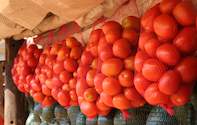Fertilization
Tomato crops require considerable nutrients including nitrogen, phosphorus and potassium and respond well to organic fertilizers. The amount of fertilizer applied is dependent on the fertility status of the soil, the season and the cultivar of tomato.

The plants have a moderately high requirement of nitrogen which promotes better growth and better flower and fruit set. They also require high levels of potassium which result in improved colour, taste, firmness, sugars, acids and solids of the fruit. Phosphorus promotes root development, early flowering and fruit set and ensures more vigorous growth.
Tomatoes also require micronutrients and deficiencies of magnesium, calcium and molybdenum are common in acid soils. Boron and copper deficiencies are no often found in tomatoes. If boron deficiencies do occur, this results in fruit cracking, pitted and corky areas, deformed shapes and uneven fruit ripening.
Iron can also possibly be deficient on calcareous, alkaline soils or after heavy lime applications. Manganese deficiencies are mainly found in calcareous soils.
Fertilizer Application (kg/hectare)
Fertilizer: 2:3:4 (30) Application time: At planting Fertile Soils: 300 to 500 Infertile Soils: 750 to 1 000 Fertilizer: LAN Application time: At 3 weeks and 6 weeks Fertile Soils: 250 + 250 Infertile Soils: 200 + 200 Fertilizer: Potassium Nitrate Application time: At 6, 9 and 12 weeks Fertile Soils: 100 + 100 + 100 Infertile Soils: 100 + 100 + 100Irrigation
Irrigation is critical in tomato production. It is important to supply sufficient water at critical times such as immediately after sowing or transplanting. The frequency of irrigation depends on the soil type and temperature. Excess irrigation after a long, dry spell without prior light irrigation results in fruit cracking.
It is best not to irrigate by overhead sprinklers as wet leaves encourage the development of early and late blight. During the first four weeks apply 21mm of water weekly. During the following eight weeks, apply 38mm per week. For the remainder of the season, apply 31mm per week. Over irrigation after the fruit has formed can cause the fruit to crack.
Crop Rotation
A three to four year-rotation programme with non-related crops is recommended to reduce the build-up of soil-borne pests and diseases.Training or Trellising
The training or trellising of plants has a number of benefits, including improved spray applications to control foliar diseases and pests, less sunburn, better air circulation and less fruit rotting.
Cultivars that have an indeterminate growth habit require training on trellises or to be suspended on twine from overhead wires. Crops grown for the fresh market should always be trellised.
Weed Control
Weeds can be controlled chemically or mechanically. Chemical weed control can be used by applying registered chemicals. Mechanical weed control, such as hand hoeing, should be shallow and not too close to the plant.Yield (tonnes per hectare)
Conservative: 30 tonnes Average: 40 to 50 tonnes Good: 80+Harvesting
The end use of the produce and the distance to the market will determine when to start harvesting. Tomatoes for processing are harvested when they are fully mature.
Tomatoes that need to be shipped a long distance are harvested at a less mature stage while for local marketing the fruit is picked at a more mature stage.
It is recommended that picking is done early in the morning and that tomatoes should be moved into the packhouse as soon as possible and not left in a hot area for long periods. In the packhouse tomatoes are cleaned, graded and packed.